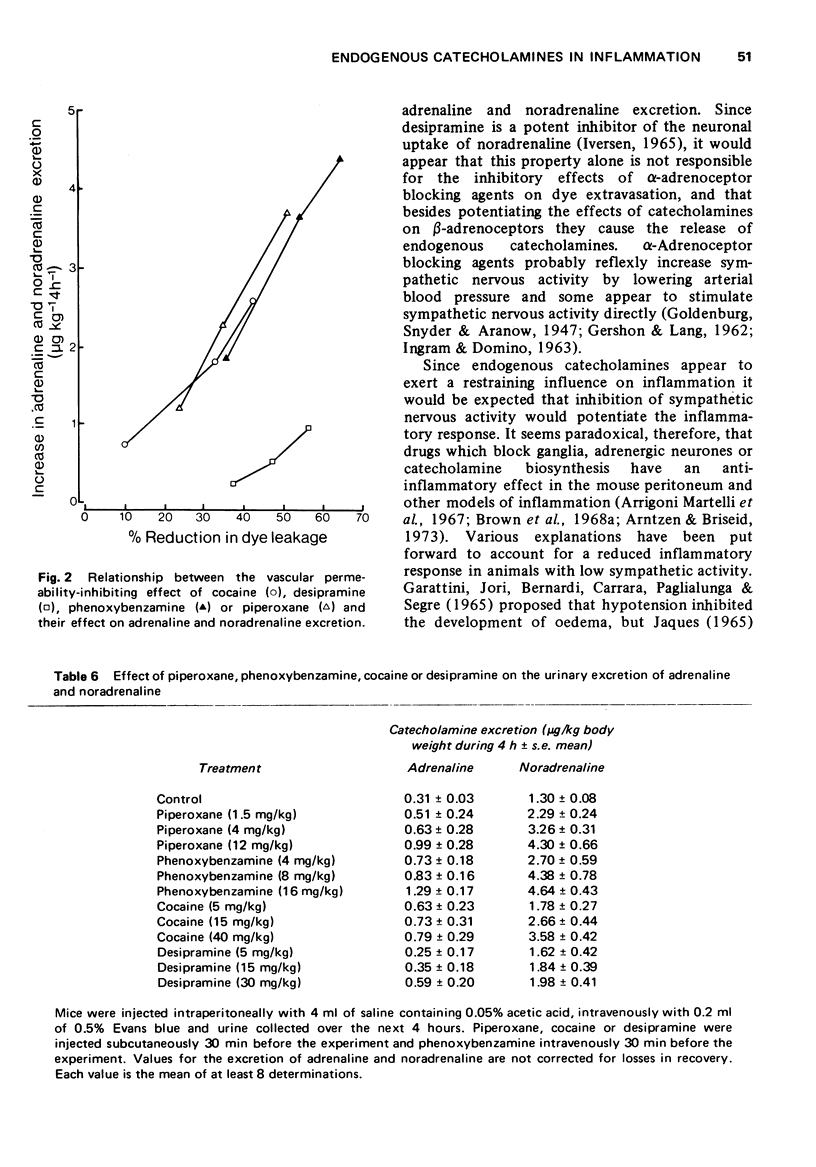Abstract
1 Drugs which release or modify the response to catecholamines were examined for their effect on the permeability of the mouse peritoneal vascular bed to circulating plasma albumin, labelled with Evans blue.
2 Phenoxybenzamine, phentolamine, piperoxane, yohimbine or cocaine reduced the extravasation of Evans blue into the peritoneum, an effect which was antagonized by β-adrenoceptor blocking drugs. The inhibitory effect of desipramine on the extravasation of Evans blue was less completely antagonized by β-adrenoceptor blockade.
3 Inhibition of catecholamine biosynthesis, ganglion blockade or adrenergic neurone blockade antagonized the reduction in dye extravasation by α-adrenoceptor blocking agents and cocaine, but had no significant effect on the response to desipramine. The inhibitory effects of α-adrenoceptor blocking agents on dye extravasation were not prevented by bilateral adrenalectomy.
4 Mice subjected to the procedure for estimation of vascular permeability excreted increased amounts of adrenaline and noradrenaline. Pretreatment with phenoxybenzamine, piperoxane or cocaine further increased catecholamine excretion, but desipramine caused only a small increase in catecholamine excretion which did not correlate with its effect on dye extravasation.
5 It is suggested that phenoxybenzamine, phentolamine, piperoxane and cocaine reduce vascular permeability in the mouse peritoneum by releasing and/or potentiating the effects of endogenous catecholamines on β-adrenoceptors. Endogenous catecholamines do not appear to be involved in the anti-inflammatory activity of desipramine.
Full text
PDF








Selected References
These references are in PubMed. This may not be the complete list of references from this article.
- ANTON A. H., SAYRE D. F. A study of the factors affecting the aluminum oxide-trihydroxyindole procedure for the analysis of catecholamines. J Pharmacol Exp Ther. 1962 Dec;138:360–375. [PubMed] [Google Scholar]
- ASCHHEIM E., ZWEIFACH B. W. Kinetics of blood protein leakage in inflammation. Circ Res. 1961 Mar;9:349–357. doi: 10.1161/01.res.9.2.349. [DOI] [PubMed] [Google Scholar]
- AXELROD J., HERTTING G., POTTER L. Effect of drugs on the uptake and release of 3H-norepinephrine in the rat heart. Nature. 1962 Apr 21;194:297–297. doi: 10.1038/194297a0. [DOI] [PubMed] [Google Scholar]
- Brown J. H., Kissel J. W., Lish P. M. Studies on the acute inflammatory response. I. Involvement of the central nervous system in certain models of inflammation. J Pharmacol Exp Ther. 1968 Mar;160(1):231–242. [PubMed] [Google Scholar]
- Brown J. H., Mackey H. K., Riggilo D. A., Schwartz N. L. Studies on the acute inflammatory response. II. Influence of antihistaminics and catecholamines on formaldehyde-induced edema. J Pharmacol Exp Ther. 1968 Mar;160(1):243–248. [PubMed] [Google Scholar]
- FARRANT J., HARVEY J. A., PENNEFATHER J. N. THE INFLUENCE OF PHENOXYBENZAMINE ON THE STORAGE OF NORADRENALINE IN RAT AND CAT TISSUES. Br J Pharmacol Chemother. 1964 Feb;22:104–112. doi: 10.1111/j.1476-5381.1964.tb01547.x. [DOI] [PMC free article] [PubMed] [Google Scholar]
- FELDBERG W., LEWIS G. P. THE ACTION OF PEPTIDES ON THE ADRENAL MEDULLA. RELEASE OF ADRENALINE BY BRADYKININ AND ANGIOTENSIN. J Physiol. 1964 May;171:98–108. doi: 10.1113/jphysiol.1964.sp007364. [DOI] [PMC free article] [PubMed] [Google Scholar]
- GERSHON S., LANG W. J. A psycho-pharmacological study of some indole alkaloids. Arch Int Pharmacodyn Ther. 1962 Jan 1;135:31–56. [PubMed] [Google Scholar]
- Green K. L., Ginsburg M. A pro-inflammatory effect of adrenaline in thermal injury. Br J Pharmacol. 1973 Jun;48(2):335P–336P. [PMC free article] [PubMed] [Google Scholar]
- Green K. L. The anti-inflammatory effect of catecholamines in the peritoneal cavity and hind paw of the mouse. Br J Pharmacol. 1972 Jun;45(2):322–332. doi: 10.1111/j.1476-5381.1972.tb08086.x. [DOI] [PMC free article] [PubMed] [Google Scholar]
- HARVEY J. A., PENNEFATHER J. N. Effect of adrenaline infusions on the catechol amine content of cat and rat tissues. Br J Pharmacol Chemother. 1962 Feb;18:183–189. doi: 10.1111/j.1476-5381.1962.tb01162.x. [DOI] [PMC free article] [PubMed] [Google Scholar]
- Harrison T. S., Seaton J. F. Tissue content of epinephrine and norepinephrine following adrenal medullectomy. Am J Physiol. 1966 Mar;210(3):599–600. doi: 10.1152/ajplegacy.1966.210.3.599. [DOI] [PubMed] [Google Scholar]
- INGRAM C. G., DOMINO E. F. Observations on the initial hypertensive response to yohimbine. Arch Int Pharmacodyn Ther. 1963;143:534–542. [PubMed] [Google Scholar]
- Jaques R. The anti-inflammatory effect of apresoline in hypotensive dosage and other hydrazines devoid of hypotensive activity. Helv Physiol Pharmacol Acta. 1965;23(1):54–60. [PubMed] [Google Scholar]
- Martelli E. A., Tóth E., Segre A. D., Corsico N. Mechanism of inhibition of experimental inflammation by antidepressant drugs. Eur J Pharmacol. 1967 Dec;2(3):229–233. doi: 10.1016/0014-2999(67)90092-1. [DOI] [PubMed] [Google Scholar]
- McCulloch M. W., Proctor C., Rand M. J. Evidence for an adrenergic homeostatic bronchodilator reflex mechanism. Eur J Pharmacol. 1967 Dec;2(3):214–223. doi: 10.1016/0014-2999(67)90090-8. [DOI] [PubMed] [Google Scholar]
- NORTHOVER B. J. The permeability to plasma proteins of the peritoneal blood vessels of the mouse, and the effect of substances that alter permeability. J Pathol Bacteriol. 1963 Apr;85:361–370. doi: 10.1002/path.1700850214. [DOI] [PubMed] [Google Scholar]
- Piper P. J., Collier H. O. Release of catecholamines in the guinea-pig by substances involved in anaphylaxis. Nature. 1967 Feb 25;213(5078):838–840. doi: 10.1038/213838a0. [DOI] [PubMed] [Google Scholar]
- Riesterer L., Jaques R. Interference, by beta-adrenergic blocking agents, with the anti-inflammatory action of various drugs. Helv Physiol Pharmacol Acta. 1968;26(3):287–293. [PubMed] [Google Scholar]
- SPECTOR S., SJOERDSMA A., UDENFRIEND S. BLOCKADE OF ENDOGENOUS NOREPINEPHRINE SYNTHESIS BY ALPHA-METHYL-TYROSINE, AN INHIBITOR OF TYROSINE HYDROXYLASE. J Pharmacol Exp Ther. 1965 Jan;147:86–95. [PubMed] [Google Scholar]
- Staszewska-Barczak J., Vane J. R. The release of catechol amines from the adrenal medulla by histamine. Br J Pharmacol Chemother. 1965 Dec;25(3):728–742. doi: 10.1111/j.1476-5381.1965.tb01795.x. [DOI] [PMC free article] [PubMed] [Google Scholar]


